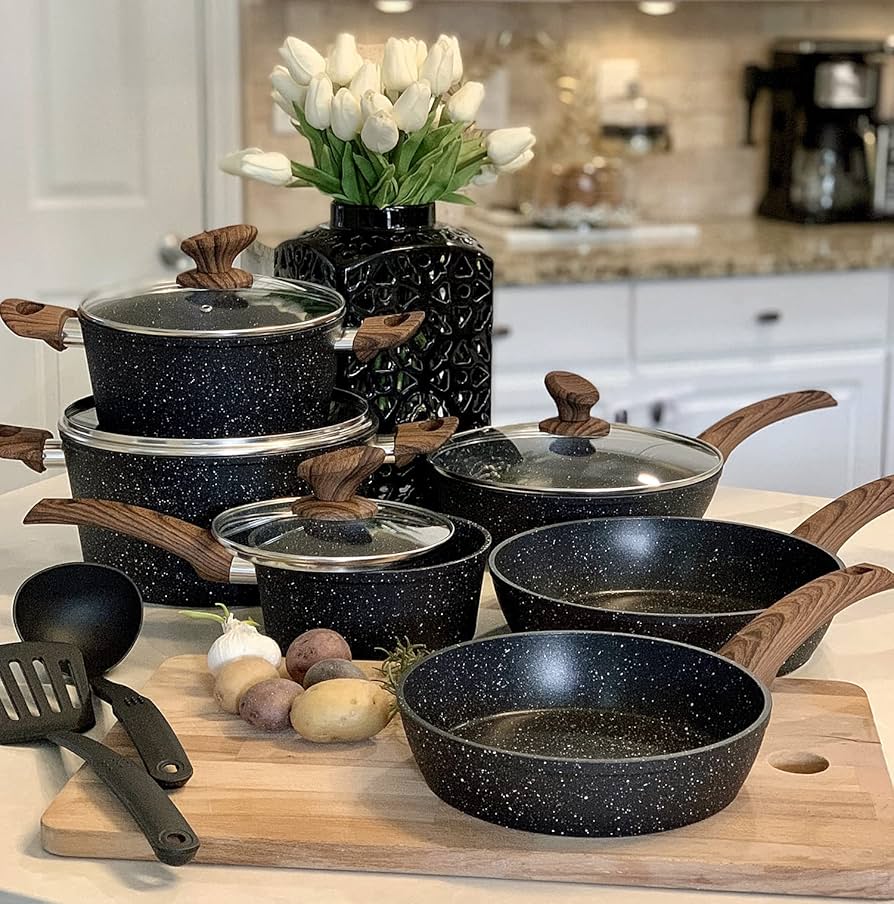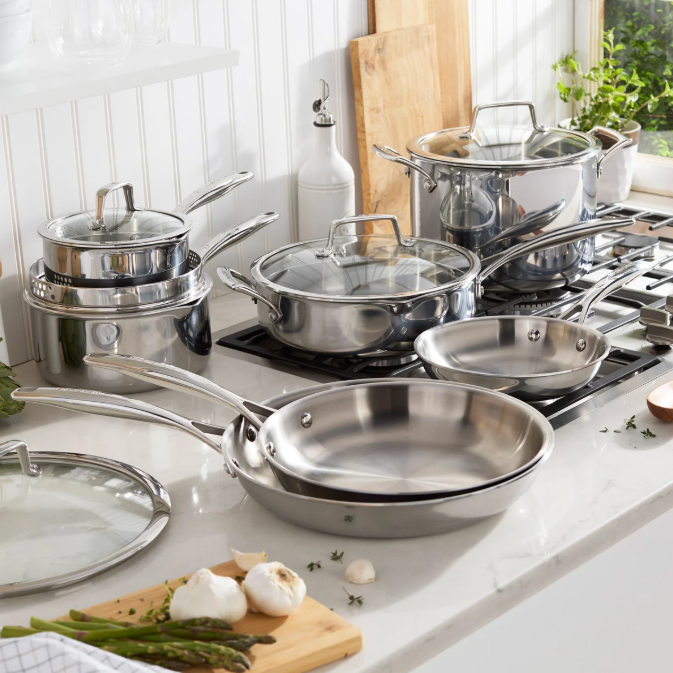So you’re standing in the kitchenware aisle, staring at rows of pots and pans, trying to decide between granite cookware and stainless steel. I get it—it’s a tough call. Both look great, both promise to make your cooking life easier, but which one actually delivers?

What Actually Is Granite Cookware?
First things first: granite cookware isn’t made from actual rock or granite stone. Despite the name, granite cookware consists of a metal core (usually aluminum or carbon steel) coated with a porcelain or ceramic-like layer that mimics the look of natural granite. The coating gives it that speckled, granite-like appearance that’s become pretty popular lately.
Think of it like this: you’ve got an aluminum base doing the heavy lifting for heat distribution, wrapped in a non-stick coating that looks fancy on your stovetop.
The Safety Question Everyone’s Asking
Let’s tackle the elephant in the room—chemicals. You’ve probably heard about PFOA, PTFE, and all those other scary acronyms floating around.
PFOA (perfluorooctanoic acid) is a carcinogen that became forbidden in 186 countries (including the US) by 2020. The good news? Most modern granite cookware is manufactured to be PFOA and PTFE-free.
But here’s where it gets tricky. Some granite cookware brands still use PTFE (you might know it as Teflon), just with a different name. Some manufacturers keep these chemicals like “a company-owned formula,” so there isn’t a lot of data available about them. That’s not exactly reassuring.
Stainless steel? Completely non-reactive, meaning it won’t alter the flavor or acidity of foods. No coatings mean no risk of peeling, scratching, or chemical exposure. You’re cooking on straight-up metal. Simple as that.
How Long Will They Last?
This is where things get really interesting.
A high-quality stainless steel pan can last a lifetime with proper care. I’m not exaggerating—stainless steel cookware used in home kitchens can last anywhere from 10 to 20 years, and in some cases 20 to 30 years with proper care. Some people are using pans their grandparents bought decades ago.
Granite cookware? Not quite the same story. While modern granite cookware has improved durability, it still does not match the longevity of stainless steel. The non-stick layer may wear off with repeated use, especially if exposed to metal utensils or high heat. You’re looking at replacing granite cookware every few years at best.
The Cooking Experience
Granite cookware shines (literally) when it comes to easy, low-fat cooking. Granite stone cookware boasts a naturally non-stick surface, reducing the need for excessive oil or butter in cooking. Scrambled eggs slide right out. Fish doesn’t stick. It’s pretty sweet for everyday cooking.
But stainless steel wins on versatility. Stainless steel cookware is versatile enough to be used in the stove or oven/broiler. Want to sear a steak at high heat, then transfer it to the oven? Stainless steel handles it without breaking a sweat. Granite cookware? Granite cookware isn’t considered safe for oven use.
Stainless steel has excellent heat distribution for even cooking, especially the good quality stuff with an aluminum core. Granite can have uneven heat distribution, which means some parts of your food might cook faster than others.
Maintenance Reality Check
Let’s be honest about what you’re signing up for.
Granite cookware requires babying. You’re supposed to use plastic or wooden utensils when working with granite cookware, not metal. Not all granite cookware brands are suitable for the dishwasher. One slip with a metal spatula and you could scratch that coating.

Stainless steel? Stainless steel can withstand more rigorous scrubbing. You can use metal utensils (though silicone or wood is still gentler). Most stainless steel is dishwasher safe. Burnt something? You can scrub it hard without worrying about damaging the pan.
What About Your Wallet?
Granite cookware is uniformly expensive across the board—a granite cookware set will usually cost much more than a steel one. And remember, you’ll need to replace it sooner.
Stainless steel comes in all price ranges. You can find budget options or invest in premium brands, but either way, you’re getting more bang for your buck over time because it lasts so much longer.
Frequently Asked Questions
Can you use metal utensils on granite cookware?
No, you really shouldn’t. Metal utensils can scratch the coating on granite cookware, which damages the non-stick surface and potentially exposes the aluminum core underneath. Stick with wood, silicone, or plastic utensils to keep your granite pans in good shape.
Does granite cookware contain actual granite?
Despite the name, granite cookware doesn’t contain real granite stone. It’s named for its appearance—the coating is made from porcelain enamel or ceramic materials that create a granite-like speckled look.
Is stainless steel cookware safe for acidic foods?
Absolutely. Stainless steel is non-reactive, which means it won’t interact with acidic ingredients like tomatoes, citrus, or vinegar. This actually makes it ideal for cooking tomato sauces and other acidic dishes without any metallic taste.
Why does food stick to my stainless steel pan?
Food sticks to stainless steel when the pan isn’t properly preheated or when you move food too soon. The trick is to heat your pan first, then add oil, let it heat, and add your food. Give it time to develop a crust before trying to flip or move it—it’ll naturally release when it’s ready.
Can granite cookware go in the dishwasher?
It varies by brand. Some granite cookware is dishwasher safe, but many manufacturers recommend handwashing to preserve the non-stick coating. Check your specific brand’s care instructions to be safe.
How do you know when stainless steel cookware needs replacing?
Look for warping (the pan wobbles on a flat surface), loose handles that can’t be tightened, deep scratches or pitting, rust that won’t come off, or if the layers start separating. Otherwise, stainless steel can last for decades.

Is granite cookware toxic?
Modern granite cookware from reputable brands is generally safe and free from PFOA, lead, and cadmium. But some brands may still contain PTFE or other chemicals. Always check that your granite cookware is specifically labeled as PFOA-free, PTFE-free, and PFAS-free for maximum safety.
Which heats up faster, granite or stainless steel?
Granite cookware typically heats up faster because it usually has an aluminum core, which conducts heat quickly. Stainless steel takes a bit longer to heat but distributes that heat more evenly once it’s hot, especially if it has an aluminum or copper core sandwiched between stainless steel layers.
The Verdict
So is granite cookware better than stainless steel? Well, it depends on what you need.
Choose granite cookware if:
- You want truly non-stick cooking right out of the box
- You’re cooking delicate foods like eggs and fish regularly
- You don’t mind being careful with utensils and cleaning
- You’re okay with replacing your cookware in a few years
Choose stainless steel if:
- You want cookware that’ll last decades
- You need something that can go from stovetop to oven
- You want the freedom to use any utensils
- You care about long-term value
- You cook at high temperatures often
Most professional kitchens use stainless steel for a reason—it’s tough, reliable, and performs consistently year after year. But for quick weeknight dinners and easy cleanup, granite cookware has its place too.
My take? If you can only choose one, stainless steel is the smarter investment. But there’s nothing wrong with having both—use stainless steel for most cooking and keep a granite pan around for those sticky situations (literally).
